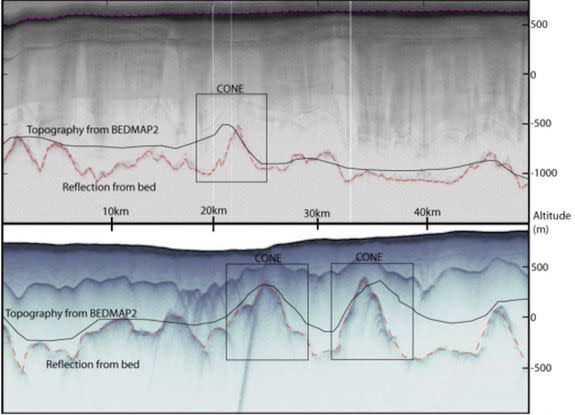Scientists discover 91 volcanoes slumbering beneath the West Antarctic Ice Sheet

In a discovery that sounds like the premise for an environmental disaster movie starring Jake Gyllenhaal, researchers say they've identified 91 previously unknown volcanoes sitting underneath the West Antarctic Ice Sheet.
Yes, that's the same ice sheet that climate scientists are concerned has slid into an irreversible collapse, due to human-caused global warming.
If verified through other studies, the new results would bring the total number of volcanoes beneath this part of Antarctica to nearly 140, and raise the unsettling possibility that subglacial heat from these volcanoes could speed up the melting of the ice.
SEE ALSO: One of the largest icebergs ever recorded just broke free of Antarctica
The study, from researchers at Edinburgh University, used radar data from aircraft and satellites that penetrates through the ice to expose the rock below. They then analyzed the observations to find basalt rock formations closely resembling volcanoes.
According to the study, the volcanoes are concentrated along the 1,864-mile-long West Antarctic Rift System, which extends from the Ross Ice Shelf to the Antarctic Peninsula.
"It is fascinating to uncover an extensive range of volcanoes in this relatively unexplored continent," said study co-author Robert Bingham, in a press release. "Better understanding of volcanic activity could shed light on their impact on Antarctica’s ice in the past, present and future, and on other rift systems around the world."
If the discovery is validated by further work, the newly-found volcanoes could make the West Antarctic Ice Sheet home to one of the densest volcanic ranges in the world, similar to East Africa's volcanic ridge.
Critically, though, the study does not indicate whether the subglacial volcanoes are currently active. But it does raise reasons to be both concerned and also potentially optimistic about how the volcanoes could either hasten or hinder Antarctic ice melt.
Heating from below is already being looked at as a contributor to glacial ice loss in Antarctica and elsewhere. A 2014 study found that geothermal heat has been hastening the melting of the Thwaites Glacier in West Antarctica, for example.

Image: M. VAN WYK DE VRIES ET AL
But one possibility the study raises is that as more ice melts above these volcanoes, it will encourage molten rock, known as magma, to flow upwards, increasing volcanic activity.
This dynamic, where melting glaciers are leading to more active volcanic activity, has been observed in Iceland, the study notes. Any additional subglacial heat would flow into the bottom of the West Antarctic Ice Sheet, speeding its flow into the sea, where it would hasten sea level rise.
There is another possibility, though, which is that the protrusions of the subglacial volcanoes could act to "pin" parts of the ice sheet in place, the study found. In this way, it could actually slow the collapse of the West Antarctic Ice Sheet.
"Numerical models used to project potential rates of WAIS [West Antarctic Ice Sheet] retreat show that, once initiated, ice retreat will continue unabated as long as the ice bed is smooth and downslopes inland, but that any increase in roughness or obstacle in the bed can act to delay or stem retreat," the study states.
"We have identified here a number of volcanic edifices sitting within the [West Antarctic Ice Sheet's] deep basins; these edifices, which are likely to owe their existence to volcanism, could represent some of the most influential pinning points for past and future ice retreat," the study says.
So, if you live in a coastal location and are worried about sea level rise, you might want to add volcanic activity to your list of things to closely watch for signs of how Antarctica will respond to a warming climate.
